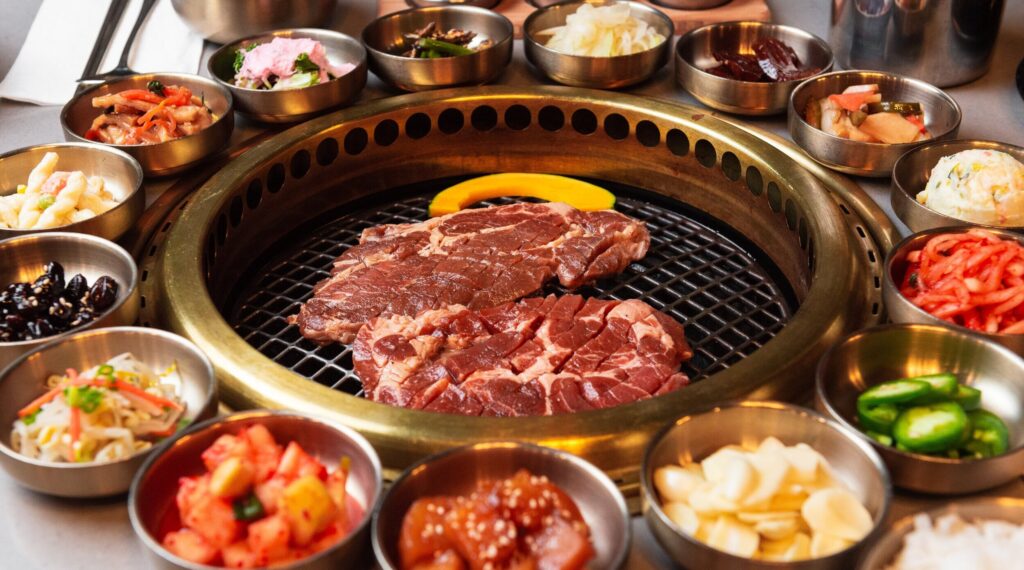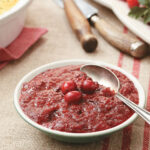The sizzling sound of the grill, the tantalizing aroma of Korean BBQ, and the camaraderie at the dining table make every gathering an unforgettable experience. However, what truly elevates the quality of Korean BBQ is the secret ingredient that brings it all together – Korean BBQ sauce. In this article, we’ll delve deep into the history of Korean BBQ, its essential components, how to craft your own sauce at home, and how this sauce can enhance the flavors of your culinary creations.
Traditional Flavors
The origins of Korean barbecue can be traced back to over a thousand years ago on the Korean Peninsula, where the practice of grilling meat was born out of necessity and innovation. In ancient Korea, given the rugged terrain and harsh winters, people needed a way to preserve and cook meat.
Koreans developed a unique method of barbecue using open flames and primitive grilling techniques. These early forms of Korean barbecue often involved skewering meat on wooden sticks and cooking it over open flames or hot coals. The meat was typically seasoned with simple ingredients like salt and wild vegetables.
As Korean cuisine evolved, so did the practice of barbecue. Around the 4th century AD, Buddhism was introduced to Korea, influencing dietary choices and leading to an emphasis on vegetarianism. However, meat remained a staple for many, and barbecue techniques continued to develop.
A significant culinary transformation occurred during the Goryeo Dynasty (918-1392) when Mongolian-style barbecue made its way to Korea. This style of barbecue involved quickly grilling thinly sliced meat on a hot grill, a practice that remains a hallmark of Korean barbecue to this day.
The Joseon Dynasty (1392-1910) witnessed further refinement of Korean cuisine, including the art of barbecue. Korean barbecue became more sophisticated, with different regions developing their own unique styles and seasonings. The development of distinctive sauces, including early iterations of what we now know as Korean barbecue sauce, began during this period.
In the royal courts, Korean barbecue became an integral part of culinary displays. Royal chefs experimented with various meat cutting techniques, seasonings, and barbecue methods, creating lavish feasts fit for royalty.
In the 20th century, with the introduction of modern barbecue equipment and advancements in refrigeration technology, Korean barbecue became more accessible to the general public. Korean barbecue restaurants, known as “gogi-gu-i-jip,” began to proliferate in Korea and eventually spread to Korean communities worldwide.
Today, sauces are a key element of Korean barbecue, and different regions of Korea contribute their own unique sauces to the world of Korean barbecue. From bold flavors in Seoul to subtle variations in Busan, each region offers its interpretation of this culinary delight, providing diners with a taste experience unlike any other barbecue from around the world. It not only enhances the flavors but also defines the character of the dishes.

The Key Ingredients: Essential Components of Korean BBQ Sauce
When discussing Korean BBQ sauce, understanding its core ingredients is akin to unlocking the secret to its irresistible flavor. While these components may vary slightly depending on the recipe, three fundamental ingredients are prevalent in nearly every batch:
Gochujang: The Spicy Heartbeat – At the core of Korean BBQ sauce lies gochujang, a spicy and fermented chili paste that is a cornerstone of Korean cuisine. Gochujang provides the sauce with its signature spiciness and depth of flavor.
Soy Sauce: The Salty Harmony – Soy sauce brings a rich, savory, and salty component that balances the spiciness of gochujang. It contributes a deep umami flavor that melds seamlessly with the other ingredients.
Sugar: The Sweet Elegance – Sugar, typically brown or white, adds a touch of sweetness that balances the sauce’s heat and saltiness. It creates a delightful caramelization during grilling, enhancing the overall texture and flavor of the dish.
These three essential ingredients create a symphony of flavors in Korean BBQ sauce, intertwining to form a complex and well-rounded taste that tantalizes your taste buds with every bite. Whether you’re enjoying it as a dip, marinade, or glaze, these essential components ensure that Korean BBQ sauce is always a delight to savor.
In the next sections, we’ll explore the craft of making the perfect Korean BBQ sauce, its applications in various culinary adventures, the delicate balance between authenticity and sustainability, and much more. So, stay tuned for a deeper dive into the world of Korean BBQ sauce!
Crafting the Perfect Korean BBQ Sauce
Homemade vs. Store-Bought
Whether you’re an experienced chef or a kitchen novice, crafting the perfect Korean BBQ sauce can be a satisfying culinary adventure. While you can conveniently purchase Korean BBQ sauce from the store, for cooking enthusiasts, making Korean-style BBQ sauce from scratch can be a source of joy. Creating your own sauce from scratch allows you to have complete control over the flavor profile, enabling you to customize it according to your exact taste preferences. You can adjust the spiciness, sweetness, and saltiness to create the sauce that suits your palate best. Moreover, homemade sauce gives you the opportunity to use fresh, high-quality ingredients, ensuring exceptional taste and aroma. You can experiment with different varieties of chili paste, soy sauce, and sugar to create a unique and personalized sauce. Additionally, homemade Korean BBQ sauce is free from artificial additives and preservatives, making it a healthier choice for those concerned about food ingredients.
However, for those with busy lifestyles or limited access to specific ingredients, store-bought Korean BBQ sauce offers a convenient solution. Many well-known brands produce ready-made Korean BBQ sauces that capture authentic Korean flavors. These sauces come in various styles, from traditional to modern interpretations, catering to different levels of spiciness. While store-bought sauces may not offer the same level of customization as homemade ones, they are a time-saving option for those who crave the unique flavors of Korean BBQ without the fuss. When choosing store-bought Korean BBQ sauce, it’s best to read labels carefully, as some brands may contain additives or high sodium content. Look for sauces that prioritize natural ingredients and traditional recipes for a more authentic experience.
Homemade Korean BBQ Sauce Recipe
For those who appreciate the art of making their own sauce, here’s a basic homemade Korean BBQ sauce recipe that you can adjust to your liking:
Ingredients
1/2 cup of gochujang (chili paste)
1/4 cup of soy sauce
1/4 cup of brown sugar
2 tablespoons of rice vinegar
2 cloves of garlic, minced
1 teaspoon of ginger, minced
1 tablespoon of toasted sesame oil
1 tablespoon of toasted sesame seeds (for garnish, optional)
Instructions
In a medium-sized bowl, mix together the gochujang, soy sauce, brown sugar, rice vinegar, minced garlic, and minced ginger. Stir all the ingredients together until the brown sugar is completely dissolved.
Gradually add the toasted sesame oil while continuing to stir. This adds a delightful nutty flavor and aroma to the sauce.
Taste the sauce and adjust the flavors to your liking. If you prefer it spicier, add more chili paste; for extra sweetness, add more sugar; if you desire more saltiness, you can add more soy sauce.
Once the sauce is balanced and suits your taste, transfer it to a sealed container. Let it sit in the refrigerator for at least an hour before using to allow the flavors to meld together.
When you’re ready to use the sauce, garnish it with toasted sesame seeds for an extra layer of flavor and presentation.
This homemade Korean BBQ sauce recipe is an excellent starting point, but don’t hesitate to further experiment and customize. You can add ingredients like grated pear for natural sweetness or minced red chili peppers for extra heat. By making your own Korean BBQ sauce, you can experience the joy of culinary creativity and savor a sauce tailored to your taste.
Popular Brands
If you opt for the convenience of buying store-bought Korean BBQ sauce, consider the following well-known brands:
CJ Bibigo – CJ Bibigo’s Korean BBQ sauces come in various flavors, allowing you to explore different tastes, from sweet and spicy to smoky and savory.
Lee Kum Kee – A trusted brand in the Asian sauce arena, Lee Kum Kee offers Korean BBQ sauces that blend traditional flavors with modern convenience.
Culinary Adventures with Korean BBQ Sauce
Korean BBQ sauce is not limited to just grilling; it’s a versatile culinary companion that can enhance a wide range of dishes, from traditional Korean cuisine to international fusion delights. Here are some creative ways to incorporate Korean BBQ sauce into different types of cuisine.

Use Korean BBQ Sauce as a Cooking Marinade
Korean BBQ Tacos: Marinate thinly sliced beef or pork in Korean BBQ sauce, grill it to perfection, then place it in warm tortillas along with kimchi slaw, cilantro, and a squeeze of lime for a tantalizing fusion of Korean and Mexican flavors.
Korean BBQ Burger: Mix Korean BBQ sauce into your burger patties to elevate your burger game. Top with pickled radishes and a fried egg for a delightful fusion experience.
Korean BBQ Pizza: Replace traditional tomato sauce with Korean BBQ sauce and explore the world of Korean BBQ pizza. Sprinkle with marinated grilled meat, mozzarella cheese, scallions, and a little extra sauce for a unique and delicious flavor.
Stir-Fries with Korean BBQ Sauce: Incorporate Korean BBQ sauce into your stir-fries for a sweet and spicy kick. This sauce pairs wonderfully with vegetables, tofu, or thinly sliced meat, adding depth and complexity to your stir-fry.
Using Korean barbecue sauce for marination
Korean barbecue sauce is also well-suited for marinating various ingredients, unleashing its magic by infusing unique flavors into meats and vegetables.
Simply coat your choice of protein, such as beef, pork, chicken, or even seafood, in the sauce and let it sit for at least an hour, preferably longer, to maximize flavor absorption. The sugars in the sauce caramelize during the grilling process, creating an enticing glaze on the exterior of the meat while keeping the inside tender and juicy.
For vegetables, marination can enhance their taste and texture. Before grilling, try marinating hearty vegetables like tofu, mushrooms, or even eggplant. The sweetness and saltiness of the sauce complement the natural flavors of the vegetables, turning them into delicious side dishes or main courses.
Use Korean BBQ Sauce as a Dipping Sauce
Spring Rolls: Korean BBQ sauce makes an excellent dipping sauce for fresh spring rolls, adding an exciting flavor dimension to this classic appetizer.
Chicken Wings: Coat your favorite chicken wings in Korean BBQ sauce to create a sweet and spicy glaze that will leave a lasting impression at your next gathering.
French Fries: Elevate your French fry game by offering Korean BBQ sauce as a dipping option. The crispy fries and the flavor of the sauce are an irresistible combination.
Sushi Rolls: Use Korean BBQ sauce as a dipping sauce for Korean-style sushi rolls to add an unexpected and delightful element to your sushi experience.
Dumplings: Whether steamed or pan-fried, dumplings pair exceptionally well with Korean BBQ dipping sauce.
Seafood: Korean BBQ sauce is a surprising yet delightful accompaniment to seafood dishes, especially when grilling or frying.
Conclusion: Savoring the Heritage of Korean BBQ Sauce
Korean BBQ sauce is not merely a condiment for grilled meats; it is a product of flavor, tradition, and innovation. It attests to the enduring global appeal of Korean cuisine, with its rich history. Therefore, whether you’re marinating, seasoning, or dipping, you can savor every moment with this captivating sauce.

Frequently Asked Questions
Q1: Can vegetarians use Korean BBQ sauce?
A1: Yes, Korean BBQ sauce can be a delightful addition to vegetarian dishes. Its sweet, savory, and spicy flavors can enhance the taste of tofu, vegetables, and even meat substitutes like seitan.
Q2: Is Korean BBQ sauce gluten-free?
A2: Some Korean BBQ sauces may contain gluten due to ingredients like soy sauce. However, there are gluten-free versions available, so be sure to check the label if you have dietary restrictions.
Q3: Can homemade Korean BBQ sauce be stored, and for how long?
A3: Homemade Korean BBQ sauce can be stored in a sealed container in the refrigerator for up to two weeks. Be sure to check for any signs of spoilage before use.
Q4: Are there low-sodium alternatives to Korean BBQ sauce?
A4: Yes, you can find low-sodium or reduced-sodium versions of Korean BBQ sauce in some stores. Additionally, you can customize homemade sauce recipes to reduce sodium content.
Q5: What are some creative uses of Korean BBQ sauce in fusion cuisine?
A5: Korean BBQ sauce can be used to make Korean BBQ tacos, sliders, pizza, and even as a glaze for grilled vegetables. Its versatility knows no bounds, so get creative in the kitchen!
































